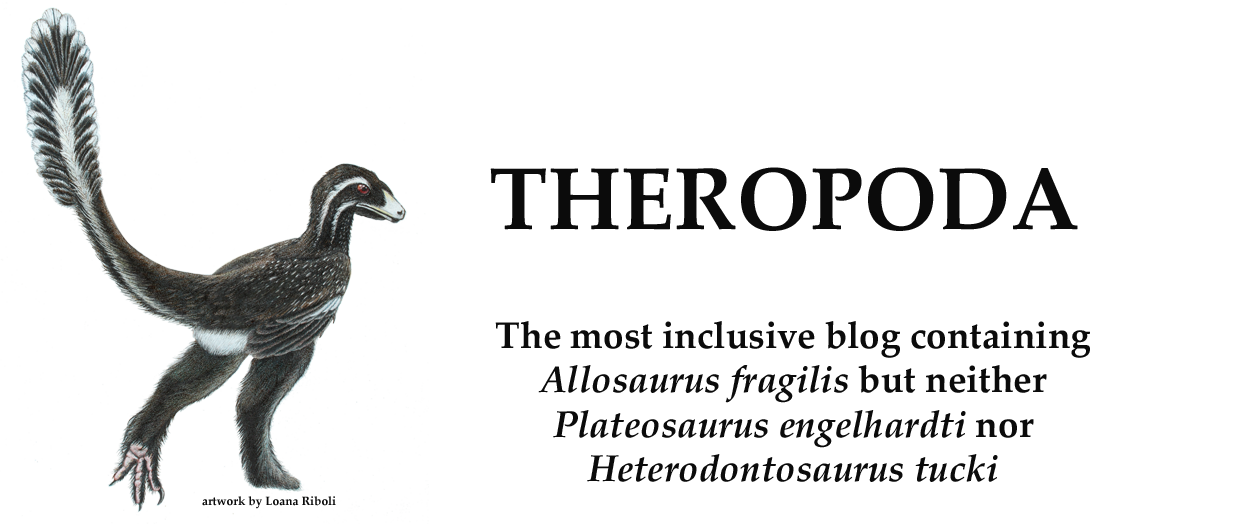Troverò mai un momento di pausa? Non faccio in tempo a mettere a riposo Megamatrice che arrivano subito nuovi taxa, interessanti, enigmatici e desiderosi di essere inclusi!
A breve, vi racconterò queste novità...
Intanto, gustatevi questa meravigliosa battaglia tra theropodi, mille volte più avvincente delle cavolate infarcite di errori di Jurassic Park III. (Grazie a Leo Ambasciano per il link)
Intanto, gustatevi questa meravigliosa battaglia tra theropodi, mille volte più avvincente delle cavolate infarcite di errori di Jurassic Park III. (Grazie a Leo Ambasciano per il link)

Sent you an email, Andrea.
RispondiEliminaSounds great... waiting for it! ^^
RispondiEliminaHi Andrea,
RispondiEliminaIf you referring to the new Baryonychinae tooth from the Upper Cretaceous of China, we all believe here in Lourinha that this is definitely not a Spinosauridae at all! It's even not conical...
C.
Hi Christophe,
RispondiEliminaNo, I'm not referring to that tooth (I cited it in the 26 January 2010 post), but to other new specimens.
Interesting. What is your interpretation of that tooth? I've always considered the "baryonychine tooth morphology" a grade and not a clade, that is , as "velociraptorine tooth morphology" may be non-dromaeosaurine non-unenlagiine dromaeosaurid morphology, I consider "baryonychine tooth morphology" as non-spinosaurine spinosaurid morphology. This may imply that baryonychine teeth fills the evolutionary transformational series between basal tetanuran and spinosaurine tooth morphologies, so, some "baryonychine" teeth may be "less spinosaurid" than others. This is what seems in the Chinese tooth. Although differing in cross section and absence of marked flutings, the new Chinese tooth shares spinosaurid features. Could it belong to a basal spinosaurid outside the spinosaurine-baryonychine node, or do you think it's from a different zyphodont archosaur, maybe crocodylian?
Interestingly (though obviously it depends on the accuracy of the measurements and identifications) it's not the least compressed baryonchine tooth reported. With a compression index of 0.6, though pretty far down there, Sánchez-Hernandez et al. 2007 describe supposed baryonchine teeth even less conical in form, and Canudo et al. 2008 give measurements of several teeth very close (0.62 is the smallest, with several at 0.65).
RispondiEliminaNot saying that you're necessarily wrong Cristophe (or that they're necessarily right in their identifications), just that other reported baryonchine teeth have had more morphological restriction than typically thought of for spinosaur teeth.
Sorry for the delay, guys, I had lot's of work these last days and I went to the field yesterday.
RispondiEliminaWell, honestly I have to admit I don't have strong arguments to say this tooth does not belong to a spinosaurid. According to some people here, it does not look like a baryonychine tooth at all (cf. teeth from Suchomimus and Baryonyx that some of them have personally examined). As my PhD project is focused on theropod teeth and megalosauroid teeth the first year, I will certainly be able to reply deeply to your questions in about one year. And hopefully, I will be able to say whether the baryonychine tooth morphology is a grade instead of a clade. Therefore, I prefer studying that in detail before replying to your questions.